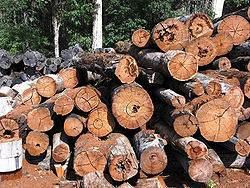Saw pit
At one time, sawyers were important members of the rural community, because many implements, as well as buildings, were made of wood.[3] The top-sawyer's work had to be very accurate; it was he who kept a careful balance on the log and guided the long saw, who kept the cuts straight or curved as required, and who estimated the width of the planks.He was the man in charge of the operation, and it wasn't uncommon for nicknames such as 'William Top-sawyer' to be common currency in country areas.[citation needed] Early sawmills adapted the whipsaw to mechanical power, generally driven by a water wheel.[citation needed] Several early sawmills in England were burned by sawyers who were fearful of losing their livelihoods.Old OS maps circa 1860 often show the location of saw pits, but by the start of the 20th century very few remained and most are no longer in use.[citation needed] Saw pits were introduced into the Royal Dockyards of Britain in the mid 18th century.[15] The saw pit at Llanaeron Home Farm is unusually housed in a single-story open-fronted building.In 1642 Lord Wharton raised a regiment of foot soldiers and a troop of horsemen to fight in the Battle of Edgehill.[17] The settlement of Saw Pit in the United States of America eventually outgrew this name and became Port Chester by incorporating as a village in 1868.


Sawpit, ColoradoKalomotimberwhipsawshipbuildingsawyerEnglandtwo-man sawHierapolisHierapolis sawmillSawmillsmedievalVillard de HonnecourtMadeiraCornelis Corneliszoonpitman armwater wheelOS mapsRoy UnderhillBritainpenal coloniesTasmaniaWilliam BlighHMS BountyAdventure Bay, TasmaniamutinyMutiny on the BountyBotany BaySydney CoveSydneyLlanaeron Home FarmQ-pitsWhite coalWilliam ShakespeareLord WhartonBattle of EdgehillPort Chesterstatutory townSan Miguel CountyCoteheleRestronguet PointFalmouthChichesterNettlehirstforestry plantationTheFreeDictionary.comPaterson, JamesRackham, Oliver